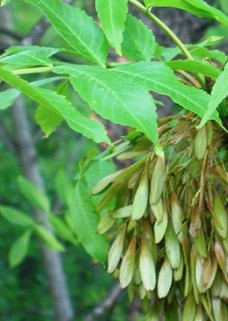 The ash tree of Shakespeare is probably the European ash, Fraxinus excelsior. It is native to most of Europe and southwestern Asia but grows in parts of the US, Canada, and New Zealand. European ash is a large deciduous tree growing to 115 feet tall and bearing pinnately compound leaves over thirteen inches long, each with seven to thirteen leaflets. The dark purple apetalous male and female flowers may be found on the same or different trees and open before the leaves appear. The seeds are produced in dry winged fruits called samaras that often hang in bunches into winter and are called “ash keys”.
The ash tree of Shakespeare is probably the European ash, Fraxinus excelsior. It is native to most of Europe and southwestern Asia but grows in parts of the US, Canada, and New Zealand. European ash is a large deciduous tree growing to 115 feet tall and bearing pinnately compound leaves over thirteen inches long, each with seven to thirteen leaflets. The dark purple apetalous male and female flowers may be found on the same or different trees and open before the leaves appear. The seeds are produced in dry winged fruits called samaras that often hang in bunches into winter and are called “ash keys”.
Shakespeare mentions the ash in one play, Coriolanus (act iv, sc. 5, 112). The Volscian general Tullus Aufidius says to the Roman general Coriolanus;
Let me twine
Mine arms about that body, where against
My grained Ash an hundred times hath broke,
And starr’d the moon with splinters.
Ash in this context probably referred to Aufidius’ bow. Ash wood was traditionally used for bows because of its flexibility, resistance to splitting, and shock resistance. Ash trees are a common sight in England and are especially beautiful in the northern areas of the country.